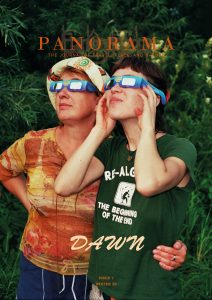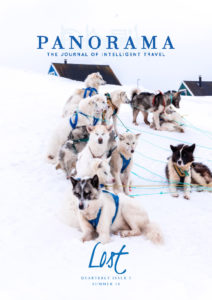Design for Migration is a platform that highlights design projects that deal with migrant issues. Here we speak with the organiser — Matteo Moretti.

Matthew Webb: Design for Migration platform brings together the work of many designers, data scientists, artists, educational groups, activists who have all responded to the migrant crisis. Could you possibly start by talking about the impetus for the project and how you were able to collate and share these stories? Did you also have a specific personal motivation?
Matteo Moretti: Back in 2015, a group of journalists, sociologists, and developers, along with myself, published Europa Dreaming, a project that delves into the topic of migration and its impact on Europe. We explored both quantitative and qualitative data, starting with the flow of migrants from Lampedusa, Italy, via the Brenner Pass to northern Europe. Migration has always been a part of human history, but recent years have seen it become heavily mediatised, instrumentalised, and capable of disrupting the world’s political balance.
Our project sought to ask the question, “What happens when the European dream meets the dream of migrants?” This phenomenon has thrown the European Union into crisis, and it remains unable to react at a community level. After the publication of Europa Dreaming, I began speaking about it at conferences, public events, and presentations. In doing so, I met many incredible people and projects carried out by designers who shared the same desire to contribute to this phenomenon.
I kept in touch with these designers and began collecting all these projects, creating a small archive that I used within my lessons to stimulate students to think more broadly and deeply about design. Eventually, I realized that it would be selfish to keep this information to myself. So, I made it public by creating designformigration.com.
Since the platform was made public, we have received many spontaneous applications, which have enriched the platform. However, not all of the projects we receive are published. As a small group of colleagues, we evaluate the submissions and usually have conversations with the submitters to see if there is a practical design component that distinguishes them from more traditional forms of social work. Our three pillars are to showcase projects that can serve as models for others and inspire new forms of design and relationships in cities, while also connecting designers who work with vulnerable categories in hostile contexts.
MW: I’m struck by the sensibility and care shown in all the projects. This is in stark contrast with how the migrant crisis is often reported and rhetoric associated with migration. Can you talk about some of the people and groups you have met and the projects that you have discovered?
MM: I have come across some amazing design projects that have completely blown my mind! These projects have managed to reshape the role of design in society, something that has been lacking in recent years. They have given new strength and new visions to an aspect of design that has been dormant for far too long.
Projects such as Talking Hands, Lampedusa Cruise, Cucula, Senza Peli sulla lingua, or Stregoni have taken it upon themselves to include marginalized individuals in their designs in ways that are transformative. These projects have given these individuals new skills so that they can play a role in European society, stimulate reflection, and mitigate the prejudices that often accompany migrants and the migration phenomenon in general.
Talking Hands, for instance, is focused on creating high-end sartorial products through the collaboration between designers, tailors, and migrants. Through this collaboration, unique and unrepeatable pieces are created that tell the story of migration and new citizenships. These garments travel the world, stimulating curiosity and showcasing the beauty of cross-breeding and hybrid cultures. The participants in these projects not only learn the rudiments of the trade but also gain knowledge in economic management related to sales and the running of a tailor’s shop.
MW: Can you talk about how you have felt during this journey? What has surprised you? What has shocked you? What has made you smile? Or, cry?
MM: During my experience, I felt as though I was drifting along with the current, rather than following a traditional path. As I mentioned earlier, the project allowed me to collect many valuable projects and create an archive that helped multiple designers succeed and generate funding. Additionally, it enabled me to gather a significant amount of resources to create the book ‘Socio Social Design‘ which aimed to lay the groundwork for further research in the field of design and social design.
MW: Projects communicate through visuals, objects, guide tours. There is a holistic feel about the responses when presented together. Have designers become aware of each others work by featuring on the same platform? Has it led to collaborations, new projects, shared resources?
MM: As mentioned previously, the project’s foundation rests on three pillars, one of which is the exchange of knowledge. I am aware that some designers have formed partnerships, yet it is important to acknowledge that these projects have been initiated and executed by small group of individuals who have invested their resources, energies, and time, a crucial but also a limiting factor.
The burden of these endeavors has typically fallen solely on the shoulders of these dedicated designers, with little support from public administrations in terms of funding or administrative assistance. Despite this, these projects have greatly benefited the participants and the community at large, serving as a valuable social service.
MW: If there was one thing that you would like readers to take away what would it be? Can we buy these products? Can we contribute in other ways? What is the future of the projects that you feature?
MM: I would like more readers to reflect on the significance of diversity and coexistence for the future. Empathy is a skill that we can always improve upon, and we should encourage more readers and designers to do the same. There are several projects like Talking Hands and Conversations From Calais that work towards promoting these values. Supporting such projects by purchasing their products can make a significant difference. It’s unfortunate that some of these projects have had to reconfigure or even cease to exist due to clashes with administrations or exhaustion from everyday life. However, it’s heartening to note that very few projects have ceased due to a lack of people in need. Let’s continue to support and promote projects that champion these important values.
MW: I understand that this was also part of a wider research project. Could you briefly touch on the academic contribution of your efforts and how your work is informing others? Have policy makers also engaged with this work?
MM: Aside from my work as a designer, I’m also an Associate Professor at the University of Sassari’s Department of Architecture, Design, and Urban Planning. Through Design for migration I mapped social design practices in migration field so to contribute to what can be design in 2023, which opens up new opportunities for design, and research, too.
It also allowed to inform both the media and academia, serving as a knowledge base for university teaching or screening social design in the migration field.
My research also delves into the design of digital commons, exploring new ways of framing data as digital commons available to a broader public. It informs both my academic teaching and professional practice, including my work with Sheldon.studio (where we report on data related to climate change or the gender gap in the toponymy of European cities.
Design isn’t just social; it’s a political act, and it must be treated as such. Effecting political change, particularly on global issues such as climate change, gender inequality, or migration, is challenging. Nonetheless, one project alone cannot create such significant transformations. If we are to see real change, it will require the effort and collaboration of as many forces as possible.
MW: Finally, what are the best resources for readers to be kept abreast of the migrant crisis? With the ongoing wars, climate change, and other geo-political issues we will inevitably see more migration. Are there signs that international cooperation is improving? Will the journeys of refugees and migrants become less hazardous?
MM: The UNHCR dashboard serves as a reliable source to keep track of the current situation. We must acknowledge that migration is a part of human history and nature, and it is unlikely that it will stop anytime soon, particularly with the worsening living conditions on our planet. However, the real issue lies in the political aspect rather than the migration itself. Unfortunately, we are witnessing the rise of nationalist and xenophobic right-wing movements, which is a cause for concern. While it may be challenging to delve into the complexities of socio-political analysis in just a few lines, it is crucial to remain optimistic and hope for the best despite the contradictory signs.













